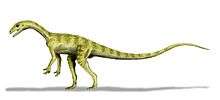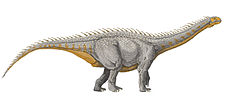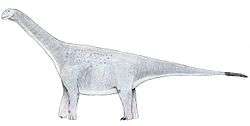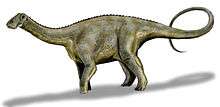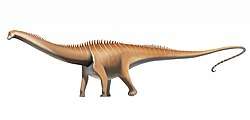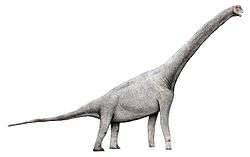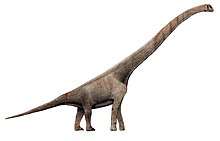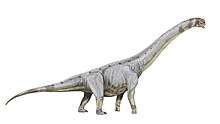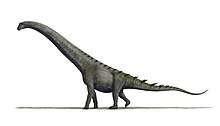Lithostrotia
Lithostrotia is a clade of derived titanosaur sauropods that lived during the Early Cretaceous and Late Cretaceous. The group was defined by Unchurch et al. in 2004 as the most recent common ancestor of Malawisaurus and Saltasaurus and all the descendants of that ancestor. Lithostrotia is derived from the Ancient Greek lithostros, meaning "inlaid with stones", referring to the fact that many known lithostrotians are preserved with osteoderms. However, osteoderms are not a distinguishing feature of the group, as the two noted by Unchurch et al. include caudal vertebrae with strongly concave front faces (procoely), although the farthest vertebrae are not procoelous.
| Lithostrotians | |
|---|---|
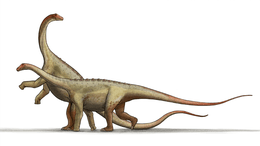 | |
| Life restorations of a pair of Saltasaurus | |
| Scientific classification | |
| Kingdom: | Animalia |
| Phylum: | Chordata |
| Clade: | Dinosauria |
| Clade: | Saurischia |
| Suborder: | †Sauropodomorpha |
| Clade: | †Sauropoda |
| Clade: | †Titanosauria |
| Clade: | †Eutitanosauria |
| Clade: | †Lithostrotia Upchurch et al., 2004 |
| Subgroups | |
| |
History of research
In 1895, Richard Lydekker named the family Titanosauridae to summarize sauropods with procoelous (concave on the front) caudal vertebrae.[2] The name Titanosauridae has since been widely used, and was defined by Salgado and colleagues (1997), Gonzalaz-Riga (2003) and Salgado (2003) as node-based taxon.[3] According to a proposal by Wilson and Upchurch (2003) looks today much of the research on the use of that name from: Wilson and Upchurch published a revision of the genus Titanosaurus and declare the type species Titanosaurus indicus as invalid because it is based only on two vertebrae of the tail, showing no diagnostically usable features. Consistently these authors consider ranking groups that are based on Titanosaurus as the nominal taxon, Titanosauridae, Titanosaurinae and Titanosauroidea - also considered invalid.[2] In 2004 Upchurch and colleagues presented the new group Lithostrotia to describe the same group as Titanosauridae, but instead it was not based upon a specific taxon.[4] The name Lithostrotia is not currently recognized by all researchers.[5]
Definition and synapomorphies
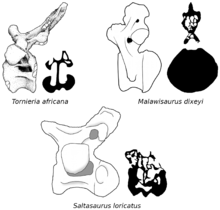
Upchurch and colleagues (2004) define the Lithostrotia as a node-based taxon that includes the last common ancestor of Malawisaurus and Saltasaurus and all descendants of that ancestor. According to this definition the Lithostrotia includes all forms that are more derived than Malawisaurus in phylogenies.[4]
In addition to defining the group Upchurch and colleagues gave two common derived features (synapomorphies), which serve to distinguish the group from non-members. The first is that all caudal vertebrae apart from the farthest distal were procoelous, meaning their front face was concave. Also, the front (proximal) caudal vertebrae were particularly strong procoelous. This first feature is also shared with Mamenchisauridae.[4]
Unchurch et al. named Lithostrotia based on the presence of osteoderms in many members, but the eponymous osteoderms do not represent synapomorphy, as the evolutionary history of osteoderms is unknown within the titanosaurs. It may be this trait has developed multiple times independently within the titanosaurs and Lithostrotia, as osteoderms are known in many saltasaurids, Mendozasaurus, Aeolosaurus, Ampelosaurus and various other genera both within and outside Lithostrotia with different morphologies.[6]
Systematics
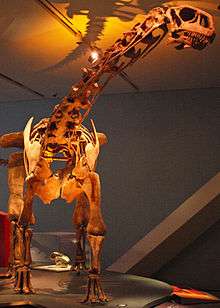
Lithostrotia is a derived group of titanosaurs, excluding primitive forms such as Andesaurus and Phuwiangosaurus.[4] The possibly equivalent clade Titanosauridae was positioned in a phylogenetic analysis by Calvo et al. (2007), where it included all titanosaurs apart from Andesaurus, though multiple primitive forms were not analyzed.[5] Other phylogenies, by Unchurch et al. (2015), instead have found a few, non-lithostrotian titanosaurs, or nearly all non-brachiosaurid titanosauriformes within the group.[7] Poropat et al. (2015) conducted a similar analysis to one of Unchurch et al. (2015). This analysis found that Andesaurus, Argentinosaurus and Epachthosaurus were within Titanosauria but outside Lithostrotia, and the latter group included Malawisaurus, Nemegtosaurus, Diamantinasaurus, Tapuiasaurus and Alamosaurus as basal lithostrotians outside Saltasauridae. The results of their analysis is shown below.[8]
| Titanosauria |
| ||||||||||||||||||||||||||||||||||||||||||||||||||||||||||||||||||||||||||||||
Another phylogenetic analysis in 2016, partially reproduced below, found Diamantinasaurus as a non-lithostrotian titanosaur and the sister taxon of the contemporary Savannasaurus.[9][10]
| Titanosauria |
| ||||||||||||||||||||||||||||||||||||||||||||||||||||||||||||||||||||||||||||||||||||||||||||||||||||||||||||
The cladogram below follows Mocho et al. (2019) with the new subgroup called Lirainosaurinae.[11]
| Lithostrotia |
| |||||||||||||||||||||||||||||||||||||||||||||||||||||||||||||||||||||||||||||||||||||||||||||||||||||||||||||||||||||||||||||||||||||||
References
- Silva, J.C.G. Jr.; Marinho, T.S.; Martinelli, A.G.; Langer, M.C. (2019). "Osteology and systematics of Uberabatitan ribeiroi (Dinosauria; Sauropoda): a Late Cretaceous titanosaur from Minas Gerais, Brazil". Zootaxa. 4577 (3): 401–438. doi:10.11646/zootaxa.4577.3.1. PMID 31715707.
- Wilson, J.A.; Upchurch, P. (2003). "A revision of Titanosaurus Lydekker (Dinosauria – Sauropoda), the first dinosaur genus with a "Gondwanan" distribution". Journal of Systematic Palaeontology. 1 (3): 125–160. doi:10.1017/S1477201903001044. ISSN 1477-2019.
- Paul Sereno. "Titanosauridae". Taxon Search. Archived from the original on 2014-09-03. Retrieved 2014-08-28.
- Upchurch, P.; Barrett, P.M.; Dodson, P. (2004). "Sauropoda". In Weishampel, David B.; Dodson, Peter; Osmolska, H. (eds.). The Dinosauria (2nd edition). University of California Press. pp. 259–322.
- Calvo, J.O.; Porfiri, J.D.; González-Riga, B.J.; Kellner, A.W. (2007). "A new Cretaceous terrestrial ecosystem from Gondwana with the description of a new sauropod dinosaur". Anais da Academia Brasileira de Ciências. 79 (3): 529–41. doi:10.1590/S0001-37652007000300013. PMID 17768539.
- D'Emic, M.D.; Wilson, J.A.; Chatterjee, S. (2009). "The titanosaur (Dinosauria: Sauropoda) osteoderm record: review and first definitive specimen from India". Journal of Vertebrate Paleontology. 29 (1): 165–177. doi:10.1671/039.029.0131. ISSN 0272-4634.
- Upchurch, Paul; Mannion, Philip D.; Taylor, Michael P. (2015). "The Anatomy and Phylogenetic Relationships of "Pelorosaurus" becklesii (Neosauropoda, Macronaria) from the Early Cretaceous of England". PLOS ONE. 10 (6): e0125819. Bibcode:2015PLoSO..1025819U. doi:10.1371/journal.pone.0125819. PMC 4454574. PMID 26039587.
- Poropat, S.F.; Upchurch, P.; Mannion, P.D.; Hocknull, S.A.; Kear, B.P.; Sloan, T.; Sinapius, G.H.K.; Elliot, D.A. (2014). "Revision of the sauropod dinosaur Diamantinasaurus matildae Hocknull et al. 2009 from the mid-Cretaceous of Australia: Implications for Gondwanan titanosauriform dispersal". Gondwana Research. 27 (3): 995–1033. doi:10.1016/j.gr.2014.03.014.
- Poropat, S.F.; Mannion, P.D.; Upchurch, P.; Hocknull, S.A.; Kear, B.P.; Kundrát, M.; Tischler, T.R.; Sloan, T.; Sinapius, G.H.K.; Elliott, J.A.; Elliott, D.A. (2016). "New Australian sauropods shed light on Cretaceous dinosaur palaeobiogeography". Scientific Reports. 6: 34467. Bibcode:2016NatSR...634467P. doi:10.1038/srep34467. PMC 5072287. PMID 27763598.
- St. Fleur, Nicholas (20 October 2016). "Meet the New Titanosaur. You Can Call It Wade". New York Times. Retrieved 21 October 2016.
- Mocho P, Páramo A, Escaso F, Marcos-Fernández F, Vidal D, Ortega F. 2019. Titanosaurs from Lo Hueco (Campanian-Maastrichtian) reveal new information about the evolutionary history of European titanosaurs, pp. 111. In: The Palaeontological Association (ed.), 63rd Annual Meeting, 15th–21st December 2019, University of Valencia, Spain, Programme Abstracts, AGM papers
